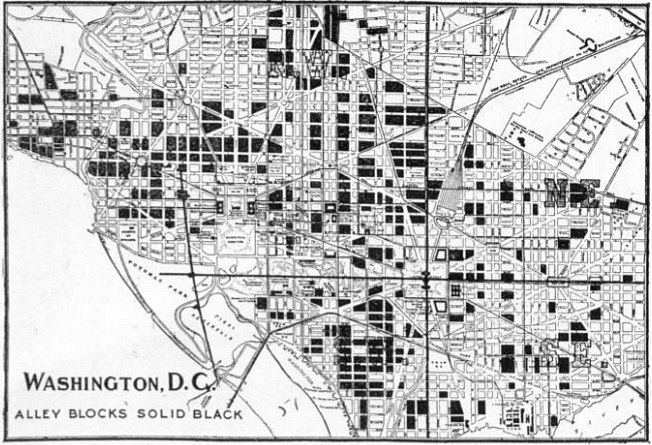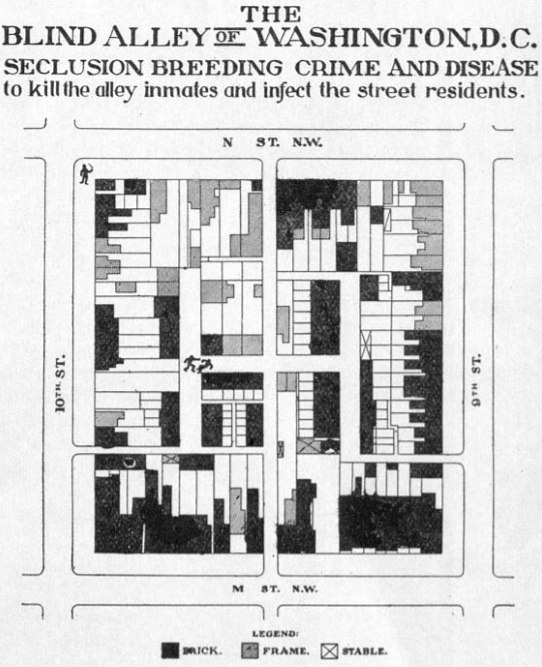 Where Have All the Alleys Gone?
Where Have All the Alleys Gone?
✉️ Want to forward this article? Click here.

In 1912, the Housing Commission of the Monday Evening Club published the "Directory of the Inhabited Alleys of Washington, DC". The guide identified 275 blocks in DC which contained habitable alleys, encompassing a total of 3,337 homes and 16,000 residents.
The publication intended to draw attention to alleys to advocate that larger alleys be converted into streets and smaller ones be eliminated entirely — an initiative which had already led to 375 alley homes being condemned and razed in the five years that preceded the publication of the directory. In the early 20th century, rather than enjoying the allure some alleys have now, these corridors were seen as cramped, undesirable breeding grounds for crime and disease.
Below, UrbanTurf takes a look at a handful of the most interesting or surprising sites where inhabited alleys were identified in 1912.

It may come as a surprise that some congressional office buildings and other seats of the federal government sit on the former sites of inhabited alleys. The site of the Hart Senate Office building used to contain Schotts Alley and its 44 residences, while the adjacent parking lot replaced Capitol Court and another 14 residences. The Supreme Court building is atop the former site of Hunts Alley and its two homes, while the site of the Rayburn House Office building used to be Temple Court, with its 14 dwellings.
An interesting example of a multi-family complex which eliminated habitable alleys is Northwest's Sursum Corda, where 199 units eventually replaced at least three alleys (Half Street Court, Logan Court and Fenton Place) and the 106 dwellings located there. This is one of many examples of inhabited alleys where the surrounding land later became a much denser residential development, although Sursum Corda's alleys were more densely-populated than most of the other upzoned alleys.
story continues below
loading...story continues above
The sites of a handful of inhabited alleys in the Northwest, Southeast and Southwest quadrants were later paved over by the city's highway network. Sullivan Court and the eight homes there sat on the current site of where I-695 and I-395 diverge. Balls Court and Seaton Court housed 29 dwellings at the site where Capitol Crossing is currently being built. An alley with two homes was later replaced with the E Street Expressway, while three alleys with 27 homes later became the I-66 on-ramp.
Of the colleges in the District, the George Washington University campus in Foggy Bottom has the most former alleys within its footprint, having been built on the site of at least eight alleys and 86 homes when it moved to the neighborhood in 1912. On the opposite end of the city, the future site of The Yards used to be home to at least three alleys with 60 dwellings. One of those alleys was called Quander Street, a name that has lasted to this day.
For more information on the history of the District's inhabited alley network, and a more current census of alley dwellings, check out this Office of Planning report.
See other articles related to: alley dwellings, alleys, blagden alley
This article originally published at http://dc.urbanturf.production.logicbrush.com/articles/blog/where-have-all-the-alleys-gone/14699.
Most Popular... This Week • Last 30 Days • Ever

With frigid weather hitting the region, these tips are important for homeowners to ke... read »

Today, UrbanTurf offers a brief explanation of what it means to lock in an interest r... read »

An application extending approval of Friendship Center, a 310-unit development along ... read »

The 30,000 square-foot home along the Potomac River sold at auction on Thursday night... read »

The number of neighborhoods in DC where the median home price hit or exceeded $1 mill... read »
DC Real Estate Guides
Short guides to navigating the DC-area real estate market
We've collected all our helpful guides for buying, selling and renting in and around Washington, DC in one place. Start browsing below!
First-Timer Primers
Intro guides for first-time home buyers
Unique Spaces
Awesome and unusual real estate from across the DC Metro













